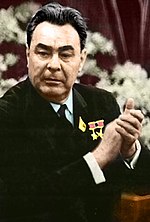Candidates had to be nominated by the Communist Party of the Soviet Union (CPSU) or by a public organisation.[2] However, all public organisations were controlled by the party and were subservient to a 1931 law that required them to accept party rule.[2] The CPSU itself remained the only legal one in the country.[3]
Voters could vote against the CPSU candidate if they wished, but could only do so by using polling booths, whereas votes for the party could be cast simply by submitting a blank ballot.[2] Turnout was required to be over 50% for the election to be valid.[2]
CPSU candidates accounted for around three quarters of the nominees, whilst many of the others were members of Komsomol.[4]
 |
|---|
| Party | Votes | % | Seats | +/– |
|---|
| Communist Party of the Soviet Union | 143,570,976 | 99.76 | 573 | –31 |
| Independents | 194 | +7 |
| Against | 345,643 | 0.24 | – | – |
| Total | 143,916,619 | 100.00 | 767 | –24 |
|
| Valid votes | 143,916,619 | 100.00 | |
|---|
| Invalid/blank votes | 412 | 0.00 | |
|---|
| Total votes | 143,917,031 | 100.00 | |
|---|
| Registered voters/turnout | 144,000,973 | 99.94 | |
|---|
| Source: Nohlen & Stöver |
Soviet of Nationalities
edit
 |
|---|
| Party | Votes | % | Seats | +/– |
|---|
| Communist Party of the Soviet Union | 143,595,678 | 99.78 | 568 | +78 |
| Independents | 182 | +20 |
| Against | 320,972 | 0.22 | – | – |
| Total | 143,916,650 | 100.00 | 750 | +98 |
|
| Valid votes | 143,916,650 | 100.00 | |
|---|
| Invalid/blank votes | 381 | 0.00 | |
|---|
| Total votes | 143,917,031 | 100.00 | |
|---|
| Registered voters/turnout | 144,000,973 | 99.94 | |
|---|
| Source: Nohlen & Stöver |
